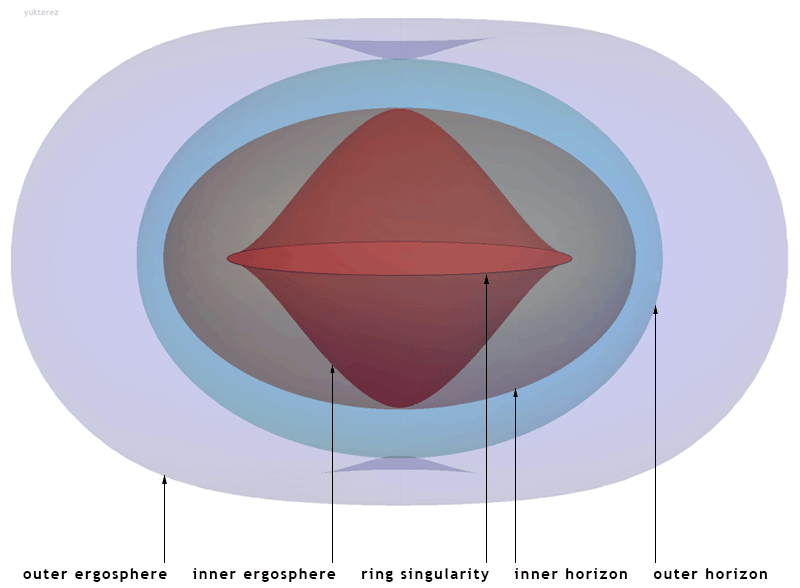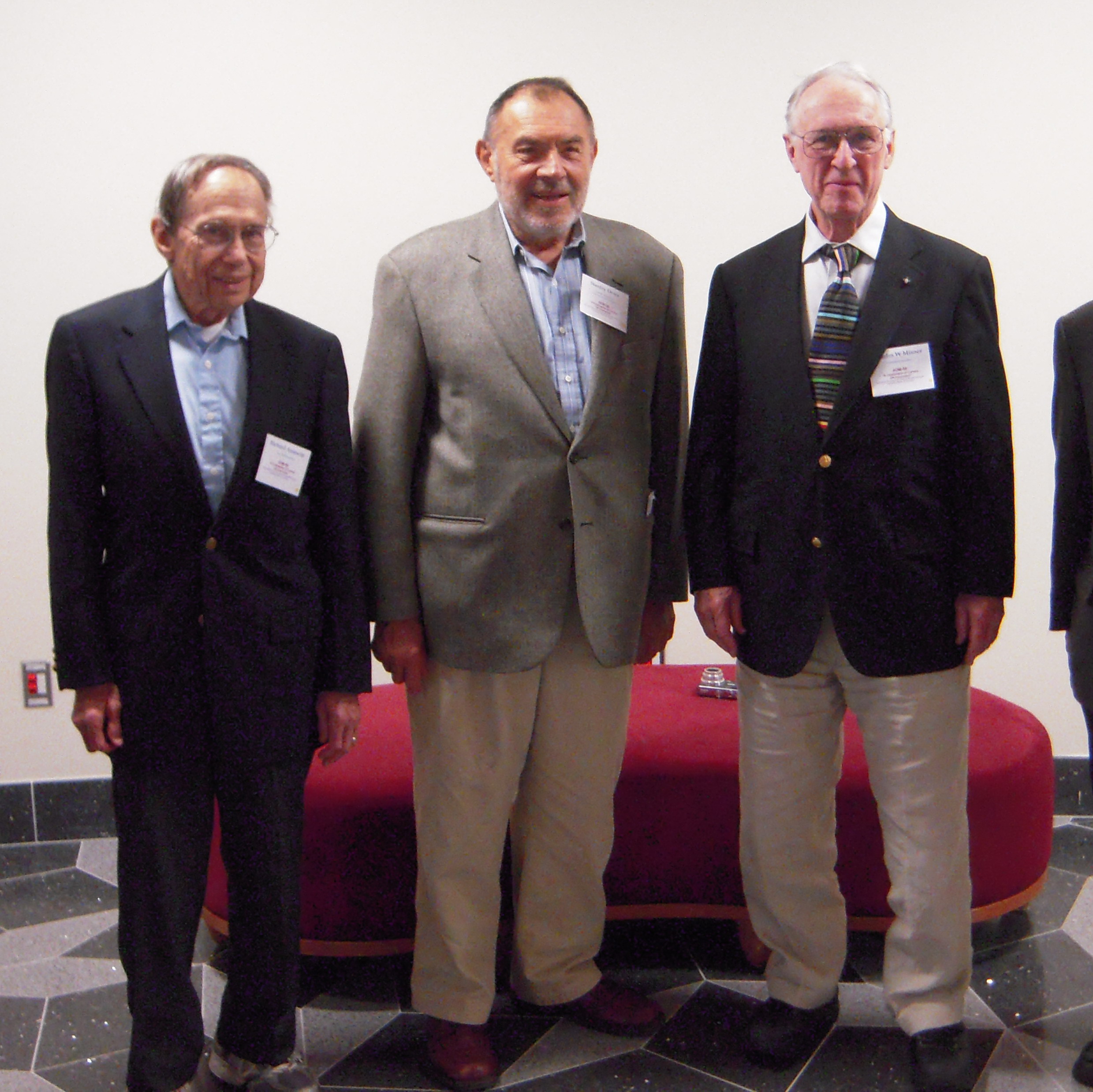|
Ruppeiner Geometry
Ruppeiner geometry is thermodynamic geometry (a type of information geometry) using the language of Riemannian geometry to study thermodynamics. George Ruppeiner proposed it in 1979. He claimed that thermodynamic systems can be represented by Riemannian geometry, and that statistical properties can be derived from the model. This geometrical model is based on the inclusion of the theory of fluctuations into the axioms of equilibrium thermodynamics, namely, there exist equilibrium states which can be represented by points on two-dimensional surface (manifold) and the distance between these equilibrium states is related to the fluctuation between them. This concept is associated to probabilities, i.e. the less probable a fluctuation between states, the further apart they are. This can be recognized if one considers the metric tensor gij in the distance formula (line element) between the two equilibrium states : ds^2 = g^R_ dx^i dx^j, \, where the matrix of coefficients ''g''''ij'' ... [...More Info...] [...Related Items...] OR: [Wikipedia] [Google] [Baidu] |
Information Geometry
Information geometry is an interdisciplinary field that applies the techniques of differential geometry to study probability theory and statistics. It studies statistical manifolds, which are Riemannian manifolds whose points correspond to probability distributions. Introduction Historically, information geometry can be traced back to the work of C. R. Rao, who was the first to treat the Fisher matrix as a Riemannian metric. The modern theory is largely due to Shun'ichi Amari, whose work has been greatly influential on the development of the field. Classically, information geometry considered a parametrized statistical model as a Riemannian manifold. For such models, there is a natural choice of Riemannian metric, known as the Fisher information metric. In the special case that the statistical model is an exponential family, it is possible to induce the statistical manifold with a Hessian metric (i.e a Riemannian metric given by the potential of a convex function). In thi ... [...More Info...] [...Related Items...] OR: [Wikipedia] [Google] [Baidu] |
Kerr Black Hole
The Kerr metric or Kerr geometry describes the geometry of empty spacetime around a rotating uncharged axially symmetric black hole with a quasispherical event horizon. The Kerr metric is an exact solution of the Einstein field equations of general relativity; these equations are highly non-linear, which makes exact solutions very difficult to find. Overview The Kerr metric is a generalization to a rotating body of the Schwarzschild metric, discovered by Karl Schwarzschild in 1915, which described the geometry of spacetime around an uncharged, spherically symmetric, and non-rotating body. The corresponding solution for a ''charged'', spherical, non-rotating body, the Reissner–Nordström metric, was discovered soon afterwards (1916–1918). However, the exact solution for an uncharged, ''rotating'' black hole, the Kerr metric, remained unsolved until 1963, when it was discovered by Roy Kerr.Melia, Fulvio (2009). "Cracking the Einstein code: relativity and the birth of black ... [...More Info...] [...Related Items...] OR: [Wikipedia] [Google] [Baidu] |
Thermodynamics
Thermodynamics is a branch of physics that deals with heat, work, and temperature, and their relation to energy, entropy, and the physical properties of matter and radiation. The behavior of these quantities is governed by the four laws of thermodynamics which convey a quantitative description using measurable macroscopic physical quantities, but may be explained in terms of microscopic constituents by statistical mechanics. Thermodynamics applies to a wide variety of topics in science and engineering, especially physical chemistry, biochemistry, chemical engineering and mechanical engineering, but also in other complex fields such as meteorology. Historically, thermodynamics developed out of a desire to increase the efficiency of early steam engines, particularly through the work of French physicist Sadi Carnot (1824) who believed that engine efficiency was the key that could help France win the Napoleonic Wars. Scots-Irish physicist Lord Kelvin was the first to formulate a ... [...More Info...] [...Related Items...] OR: [Wikipedia] [Google] [Baidu] |
Euclidean Space
Euclidean space is the fundamental space of geometry, intended to represent physical space. Originally, that is, in Euclid's Elements, Euclid's ''Elements'', it was the three-dimensional space of Euclidean geometry, but in modern mathematics there are Euclidean spaces of any positive integer dimension (mathematics), dimension, including the three-dimensional space and the ''Euclidean plane'' (dimension two). The qualifier "Euclidean" is used to distinguish Euclidean spaces from other spaces that were later considered in physics and modern mathematics. Ancient History of geometry#Greek geometry, Greek geometers introduced Euclidean space for modeling the physical space. Their work was collected by the Greek mathematics, ancient Greek mathematician Euclid in his ''Elements'', with the great innovation of ''mathematical proof, proving'' all properties of the space as theorems, by starting from a few fundamental properties, called ''postulates'', which either were considered as eviden ... [...More Info...] [...Related Items...] OR: [Wikipedia] [Google] [Baidu] |
BTZ Black Hole
The BTZ black hole, named after Máximo Bañados, Claudio Teitelboim, and Jorge Zanelli, is a black hole solution for (2+1)-dimensional topological gravity with a negative cosmological constant. History In 1992 Bañados, Teitelboim and Zanelli discovered the BTZ black hole exact solutions in general relativity, solution . This came as a surprise, because when the cosmological constant is zero, a vacuum solution of (2+1)-dimensional gravity is necessarily flat (the Weyl tensor vanishes in three dimensions, while the Ricci tensor vanishes due to the Einstein field equations, so the full Riemann tensor vanishes), and it can be shown that no black hole solutions with event horizons exist.https://journals.aps.org/prd/abstract/10.1103/PhysRevD.103.064063 But thanks to the negative cosmological constant in the BTZ black hole, it is able to have remarkably similar properties to the 3+1 dimensional Schwarzschild and Kerr black hole solutions, which model real-world black holes. Properti ... [...More Info...] [...Related Items...] OR: [Wikipedia] [Google] [Baidu] |
Heat Capacity
Heat capacity or thermal capacity is a physical property of matter, defined as the amount of heat to be supplied to an object to produce a unit change in its temperature. The SI unit of heat capacity is joule per kelvin (J/K). Heat capacity is an extensive property. The corresponding intensive property is the specific heat capacity, found by dividing the heat capacity of an object by its mass. Dividing the heat capacity by the amount of substance in moles yields its molar heat capacity. The volumetric heat capacity measures the heat capacity per volume. In architecture and civil engineering, the heat capacity of a building is often referred to as its thermal mass. Definition Basic definition The heat capacity of an object, denoted by C, is the limit : C = \lim_\frac, where \Delta Q is the amount of heat that must be added to the object (of mass ''M'') in order to raise its temperature by \Delta T. The value of this parameter usually varies considerably depending on the ... [...More Info...] [...Related Items...] OR: [Wikipedia] [Google] [Baidu] |
Specific Heat
In thermodynamics, the specific heat capacity (symbol ) of a substance is the heat capacity of a sample of the substance divided by the mass of the sample, also sometimes referred to as massic heat capacity. Informally, it is the amount of heat that must be added to one unit of mass of the substance in order to cause an increase of one unit in temperature. The SI unit of specific heat capacity is joule per kelvin per kilogram, J⋅kg−1⋅K−1. For example, the heat required to raise the temperature of of water by is , so the specific heat capacity of water is . Specific heat capacity often varies with temperature, and is different for each state of matter. Liquid water has one of the highest specific heat capacities among common substances, about at 20 °C; but that of ice, just below 0 °C, is only . The specific heat capacities of iron, granite, and hydrogen gas are about 449 J⋅kg−1⋅K−1, 790 J⋅kg−1⋅K−1, and 14300 J⋅kg−1⋅K−1 ... [...More Info...] [...Related Items...] OR: [Wikipedia] [Google] [Baidu] |
ADM Mass
The ADM formalism (named for its authors Richard Arnowitt, Stanley Deser and Charles W. Misner) is a Hamiltonian formulation of general relativity that plays an important role in canonical quantum gravity and numerical relativity. It was first published in 1959. The comprehensive review of the formalism that the authors published in 1962 has been reprinted in the journal ''General Relativity and Gravitation'', while the original papers can be found in the archives of '' Physical Review''. Overview The formalism supposes that spacetime is foliated into a family of spacelike surfaces \Sigma_t, labeled by their time coordinate t, and with coordinates on each slice given by x^i. The dynamic variables of this theory are taken to be the metric tensor of three-dimensional spatial slices \gamma_(t,x^k) and their conjugate momenta \pi^(t,x^k). Using these variables it is possible to define a Hamiltonian, and thereby write the equations of motion for general relativity in the form o ... [...More Info...] [...Related Items...] OR: [Wikipedia] [Google] [Baidu] |
Event Horizon
In astrophysics, an event horizon is a boundary beyond which events cannot affect an observer. Wolfgang Rindler coined the term in the 1950s. In 1784, John Michell proposed that gravity can be strong enough in the vicinity of massive compact objects that even light cannot escape. At that time, the Newtonian theory of gravitation and the so-called corpuscular theory of light were dominant. In these theories, if the escape velocity of the gravitational influence of a massive object exceeds the speed of light, then light originating inside or from it can escape temporarily but will return. In 1958, David Finkelstein used general relativity to introduce a stricter definition of a local black hole event horizon as a boundary beyond which events of any kind cannot affect an outside observer, leading to information and firewall paradoxes, encouraging the re-examination of the concept of local event horizons and the notion of black holes. Several theories were subsequently developed, som ... [...More Info...] [...Related Items...] OR: [Wikipedia] [Google] [Baidu] |
Newton's Constant
The gravitational constant (also known as the universal gravitational constant, the Newtonian constant of gravitation, or the Cavendish gravitational constant), denoted by the capital letter , is an empirical physical constant involved in the calculation of gravitational effects in Sir Isaac Newton's law of universal gravitation and in Albert Einstein's theory of general relativity. In Newton's law, it is the proportionality constant connecting the gravitational force between two bodies with the product of their masses and the inverse square of their distance. In the Einstein field equations, it quantifies the relation between the geometry of spacetime and the energy–momentum tensor (also referred to as the stress–energy tensor). The measured value of the constant is known with some certainty to four significant digits. In SI units, its value is approximately The modern notation of Newton's law involving was introduced in the 1890s by C. V. Boys. The first i ... [...More Info...] [...Related Items...] OR: [Wikipedia] [Google] [Baidu] |
Speed Of Light
The speed of light in vacuum, commonly denoted , is a universal physical constant that is important in many areas of physics. The speed of light is exactly equal to ). According to the special theory of relativity, is the upper limit for the speed at which conventional matter or energy (and thus any signal carrying information) can travel through space. All forms of electromagnetic radiation, including visible light, travel at the speed of light. For many practical purposes, light and other electromagnetic waves will appear to propagate instantaneously, but for long distances and very sensitive measurements, their finite speed has noticeable effects. Starlight viewed on Earth left the stars many years ago, allowing humans to study the history of the universe by viewing distant objects. When communicating with distant space probes, it can take minutes to hours for signals to travel from Earth to the spacecraft and vice versa. In computing, the speed of light fixes ... [...More Info...] [...Related Items...] OR: [Wikipedia] [Google] [Baidu] |




